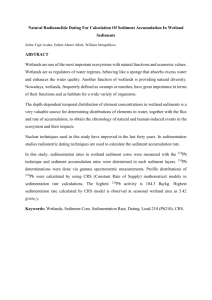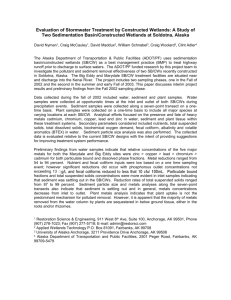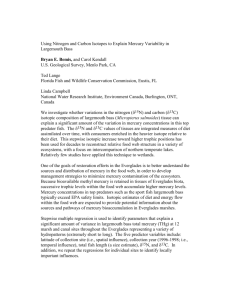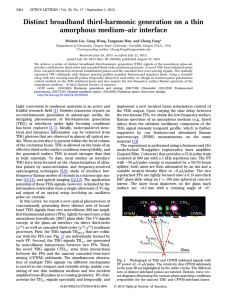Mercury Concentrations in Wetlands Associated With Coal
advertisement
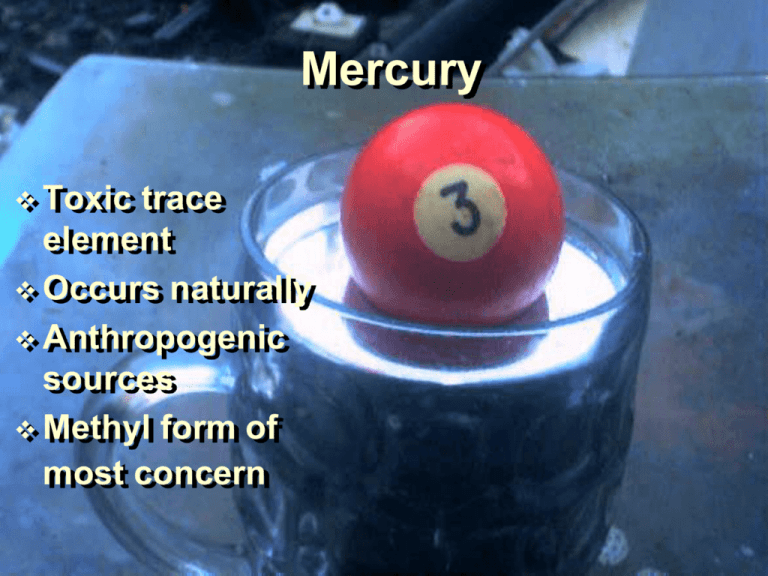
Mercury Toxic trace element Occurs naturally Anthropogenic sources Methyl form of most concern Natural sources 0 Hg Anthropogenic Sources Hg2+ Hg0 Hgp Mercury in the Environment Inorganic Hg is now the predominant source of methylated mercury Fossil fuel burning Chemical Pollution Inorganic form and methyl form both toxic Becomes methylated through natural transformations Biomagnification and bioaccumulation Top piscivorous wildlife have some of the highest levels Source: USGS modified from Cleckner et al. 1998. Wetlands and Mercury Methylmercury production. Source of methylmercury for freshwaters. Sink and source Hg0 Hg Hgp Hg2+ Mercury concentrations in wetlands associated with coal-fired power plants (CFPPs) Richard Halbrook and Scott Weir Cooperative Wildlife Research Laboratory, Department of Zoology Southern Illinois University, Carbondale, Illinois Objectives Preliminary information on total mercury (THg) in wetlands associated with coal-fired generating plants in Illinois H1: Sediment and tadpole THg will be higher downwind than upwind, and that concentrations will increase with increasing distance downwind H2: Sediment and tadpole THg concentrations will be positively correlated Specific protocols for monitoring mercury concentrations in wetland habitats Selection of Power Plants Plants were selected on the following factors: Mercury emissions Prevailing wind data Suitable wetlands The plants selected are: Joppa, Baldwin, Newton, and Southern Illinois Power Cooperative (SIPC) Sample Collections 45 total wetlands in May and June 2007 12 wetlands sampled from Baldwin and SIPC, 11 from Joppa, and 10 from Newton 3 upwind and between 3-5km 9 downwind Range: 3-5km, 8-10km, and 13-15km Map of Wetlands, IL counties, CFPPs Collection Methods Sediment sampled with core augers 3 samples from each wetland Temperature (ºC) Tadpoles sampled with dip nets Species, stage, mass, length Sediment Variables Oxidation-reduction potential pH Texture Mercury Analysis Total Hg in tadpoles determined using a Hydra AF cold vapor mercury analyzer. Tadpole digested by EPA method 245.7. Sediment digested by EPA method 3051A. Analyzed at ISTC. Statistics SAS (v 9.1) Normality, Shapiro-Wilks Analysis of covariance ANOVA Pearson Correlation (Bonferroni Correction) log Sediment THg (ng/g dry weight) Sediment Results 1.8 1.6 1.4 Baldwin Joppa SIPC Newton 1.2 1 2 3 Range 4 Upwind vs Downwind log Sediment THg (ng/g dry weight) 2.0 Downwind Upwind * 1.5 1.0 0.5 3 7 1 7 3 9 2 6 0.0 Baldwin Joppa SIPC Newton Tadpole Results (29 ponds)* Bullfrog Green Frog n Homogenized 56.80 + 6.6 (35)a 45.46 + 5.9 (36)ab 71 Whole 86.52 + 24.8 (13)a 28.23 + 3.7 (16)b 29 n *Mean + SE (n) 48 52 100 Tadpole Results log Tadpole THg (ng/g wet weight) 2.0 1.8 1.6 1.4 Baldwin Joppa SIPC Newton 1.2 1 2 3 Range 4 Tadpole upwind vs downwind log Tadpole THg (ng/g wet weight) 2.5 Downwind Upwind 2.0 1.5 1.0 0.5 2 4 4 1 6 2 3 0.0 Baldwin Joppa SIPC Newton Concentrations of importance Background conc Current Study Concentrations of concern Sediment THg 20-60 ng/g (dw)A 8-82 ng/g (dw) 180 ng/g (dw)C Aquatic Vertebrates THg <80 ng/g (ww)B AEisler 1987 BTerhivuo et al. 1984 CMacDonald et al. 2000 DHealth Canada 2007 5-318 ng/g (ww) 500 ng/g (ww)D Correlations of Tadpole Variables THg Gosner Stage Total Length (mm) THg 1 Gosner Stage -0.25* 1 Total Length (mm) -0.47*** 0.71*** 1 Weight (g) -0.39*** 0.59*** 0.81*** * = p < 0.10, *** = p < 0.01 (Bonferroni correction) Weight (g) 1 Tadpoles in the field Author Location Species Tissue Mercury conc Current study Illinois Bullfrog Green frog Whole body 63.2 ng/g 45.1 ng/g Burger and Snodgrass 2001 Savannah River, SW Carolina Acadia National Park, Maine Savannah River, W Carolina Bank et al. 2007 Unrine et al. 2005 Byrne et al. 1975 Yugoslavia Southern leopard frog Body, Tail, < 0.200 ng/g Digestive tract DL Bullfrog Green frog Whole body composite 19.1 ng/g 25.1 ng/g Southern leopard frog Carcass Gut 184 ng/g (dw) 1275 ng/g (dw) Unspecified Whole body 410, 490 ng/g Other CFPP studies Author Anderson and Smith 1977. Place Illinois Biological Unit 1 Lake, Terrestrial soil Distance from CFPP < 15 km Species Conclusions Many fish species Soil sig. > downwind, Lake sed > after ops began, Fish conc very low Wangen and Williams 1978. New Mexico Terrestrial Soil 8-120 km N/A Concentration as a function of distance were not significant for 9 elements Crockett and Kinnison 1979 Arizona Terrestrial Soil < 30 km N/A No pattern in concentric rings Pinkney et al 1997. Current Study Maryland Illinois Ponds Ponds/Wetlands 3 - 15 km Fish (bluegill, No pattern in green sunfish, concentric rings.Field largemouth results did not match bass) model 3 - 15 km No pattern for 3 of the Bullfrog, green CFPPs, Slight pattern frog larvae downwind of Newton CFPP log pond mean sediment THg (ng/g dry weight) Using tadpoles as bioindicators 1.9 1.8 1.7 1.6 1.5 1.4 1.3 1.2 1.1 0.8 1.0 1.2 1.4 1.6 1.8 log pond mean tadpole THg (ng/g wet weight) 2.0 2.2 Conclusions Preliminary information on total mercury (THg) in wetlands associated with coal-fired generating plants in Illinois H1: Sediment and tadpole THg will be higher downwind than upwind, and that concentrations will increase with increasing distance downwind (Newton CFPP Only) H2: Sediment and tadpole THg concentrations will be positively correlated (Rejected) Develop Specific protocols for monitoring mercury concentrations in wetland habitats Management Implications Concentrations of THg measured in sediment and tadpoles in wetlands surrounding Newton, Baldwin, Joppa, and SIPC CFPPs were are below levels of concern Acknowledgements Illinois Sustainable Technology Center Gary Bordson and the metals group at ISTC Marvin Piwoni Cooperative Wildlife Research Lab Department of Zoology and Graduate School Questions? Conclusions With the exception of Newton, CFPPs did not have a significant pattern of THg concentrations in ponds 3-15 km downwind Tadpole length THg was negatively correlated with Sediment THg and distance log Sediment THg (ng/g dry weight) 1.8 10 1.7 9 9 10 3 4 1.6 1.5 1.4 1.3 1.2 1 2 Range Sediment Variables Sediment THg Temperature (°C) pH Redox potential Pond area (m2)A Sediment THg 1 Temperature (°C) -0.16 1 pH -0.21 -0.22 1 Redox potential 0.24 0.16 -0.85 1 Pond area (m2)A 0.01 -0.26 0.23 -0.33 1 Tadpole THgA -0.05 -0.41 0.35 -0.14 0.01 A = Pond means were used in these correlations *** = p < 0.01 (Bonferroni correction) Tadpole THgA 1 Texture log sediment THg (ng/g dry weight) 1.8 1.6 1.4 1.2 1.0 0.8 0.6 0.4 0.2 6 15 1 2 1 d an s y nd sa la yc 13 20 8 0.0 m cla oa yl m loa m loa y nd sa s yc d an la m oa l y m oa yl nd sa am t lo sil Mercury across taxa Mammals Birds Amphibians Mechanism MeHg causes central nervous system damage Central nervous system damage Neurotoxicity (?) Physiological effects Behavioral impairment: anorexia, lethargy Weight loss, muscular incoordination Adults: ? Tadpoles: swimming behavior Readily crosses placental barrier Reduced hatchability and clutch size, eggshell thinning Effects on embryos (?) Reproduction Mercury and Amphibians MeHg Hg2+ 200-400 ng/g THg body burden Concentrations similar to fish Local vs Regional vs Global Contradicting results regarding the local effects of coal-fired power plants Studies have reported local impacts Some have stated that local impacts are overestimated Atmospheric lifespan of mercury species Quality Assurance/Quality Control Laboratory Blanks Laboratory Reagent Spikes Replicates Sediment Only: Matrix Spike Reference Material Tadpole Only: Matrix Quad Study Tadpoles are kind of a pain Feeding behavior Predation escape Metamorphosis /Physiology Newton Power Plant 2.0 Sediment Tadpole log THg (ng/g) 1.8 1.6 1.4 1.2 1.0 1 2 3 Range 4




